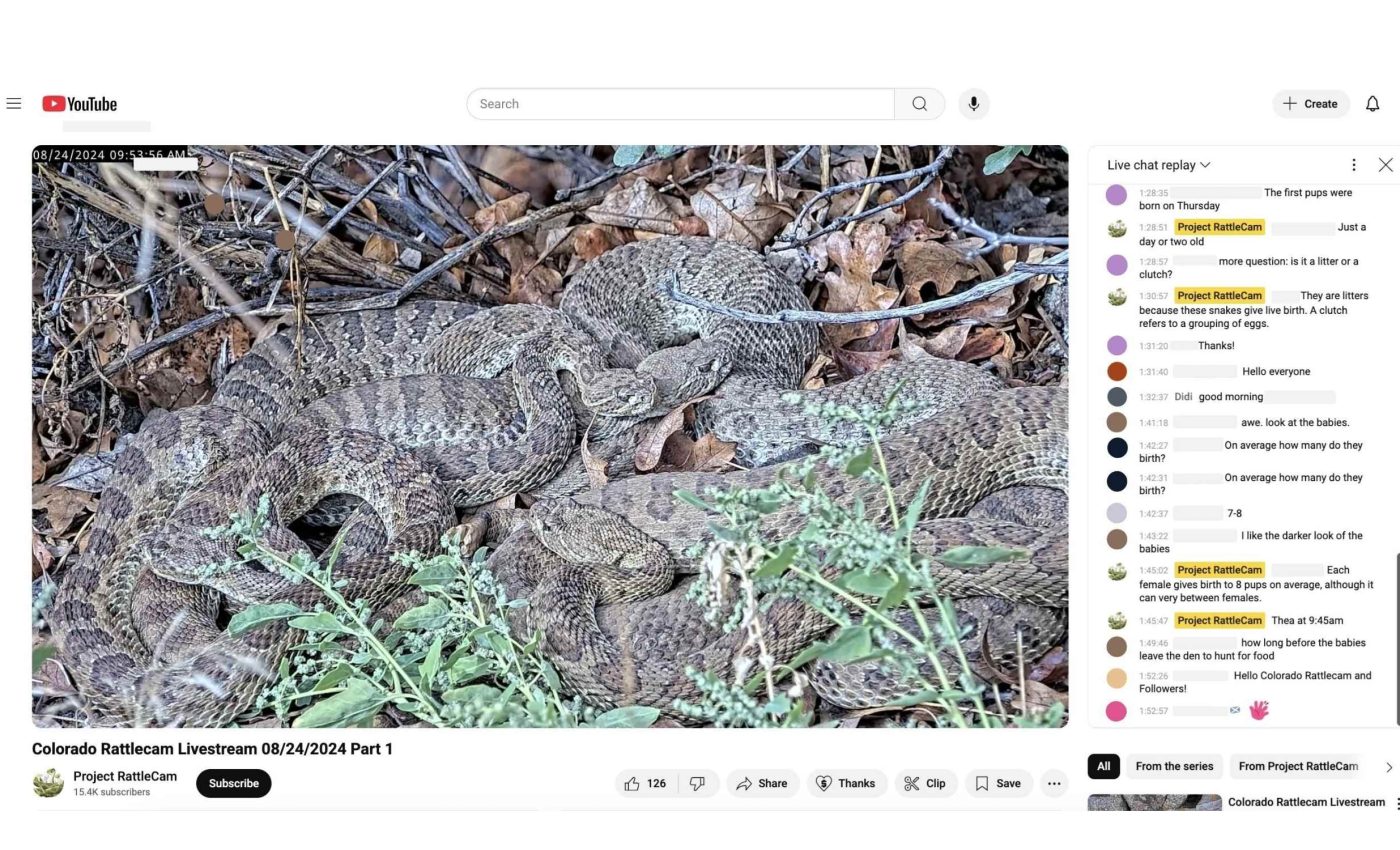
Nature cam catches video of the world's 'most hated' snakes behaving like loving mothers
A quiet camera trained on a Colorado hillside did more than just livestream snakes. It helped people rethink their attitude towards an animal that many have learned to fear.
A new research paper has shared that the RattleCam livestream project attracted over 14,500 subscribers, while following a prairie rattlesnake (Crotalus viridis) den during one active season. The work centered on a large, communal den site – known as a megaden – in northern Colorado.
Rattlesnake behavior on livestream
The work was led by Emily Taylor, a biology professor at California Polytechnic State University (Cal Poly). Her research focuses on rattlesnake ecology and public engagement.
Taylor detailed the den’s scale and the mothers’ behavior – an aspect many viewers had never seen documented before – in a single season of live observations. The team used recent advances in livestream technology to observe rattlesnake behavior in real time.
Many viewers were surprised to learn that rattlesnakes show a strong maternal side, staying near their young for days after birth and guarding them from danger. The project highlighted that these snakes are, in fact, attentive mothers, a trait rarely acknowledged or shown in popular media.
Viewers watched females bask, give birth, and remain near newborns at the den mouth. Later in the season, pups stayed close while adults shifted between sun and shade.
Why fear begins to fade
Venomous snakes often trigger stronger fear responses in people than do harmless species, a pattern confirmed by physiological measures in controlled tests. That baseline fear makes it difficult for some to experience a sense of empathy when observing snakes.
Messaging matters when tackling that fear. Experiments show that relational stories highlighting social behaviors can improve attitudes toward rattlesnakes, especially in some audiences.
A season inside the rattlesnake den
The Colorado site serves as a hibernaculum, a safe shelter where snakes gather underground to overwinter. In spring, adults emerge, and by late summer pregnant females remain while others forage miles away.
After birth, mother rattlesnakes and pups linger together in a rookery – a shared birthing area used by multiple females. That simple fact runs counter to the old notion that snakes are solitary at all times.
Biology backs those scenes. Experimental work has tied hormonal signaling to maternal care in pygmy rattlesnakes, supporting a real biological basis for attendance. The livestream cameras add natural context by showing care without handling or harsh lab lights.
Operators used night vision to observe after dark, with infrared light that many animals do not see. That let viewers follow cautious movements, cooling rain drinks, and wary pauses when hawks passed overhead.
From spectacle to science
The livestream was archived on a YouTube channel and made available to the public. A live chat, crewed by volunteer research students, doubled as community science with viewers flagging events and helping identify individual snakes. Volunteers moderated questions and logged observations that researchers could track.
Engagement spiked when babies were born, then stayed high as the rattlesnakes returned from foraging in fall. By season’s end, viewers from 122 countries had logged on 1,616,398 times, and added 175,306 watch hours. This means that the livestream had provided a large, diverse window into prairie rattlesnake behavior.
Schools also used the stream as a simple field lab. They timed basking, noted predator encounters, and compared daytime and nighttime activity, without hiking into fragile habitat.
Cameras change perceptions of rattlesnakes
In the past, events called roundups were conducted. These were public contests where rattlesnakes were collected and often killed, which harmed local populations and skewed age structures. Changing perceptions reduces support for such practices and encourages safer and less destructive options.
Safer options already exist. Professional removal and relocation keeps people and pets out of harm’s way while reducing needless killing near homes.
The cameras also show what to do around snakes. Give space, do not corner animals, and keep dogs on a leash near rocky outcrops or south facing slopes.
One season’s livestream changed the script
The project’s first full Colorado season ran daily and nightly, with brief breaks to archive the feed. Operators used presets to avoid bias, then zoomed when viewers reported activity.
Viewers learned to spot key behaviors. A lifted head, a scent flick of the tongue, and a gentle shift of coils often signaled the next move.
The camera revealed routine calm more often than threat. When disturbed, snakes typically chose to retreat rather than rattle.
Why the approach works
Seeing real behavior replaces rumor with observation. The live format is unscripted, so quiet hours are part of the story.
Scale makes learning stick. A single shared stream creates common reference points that teachers, parents, and students can discuss the same day.
Technology kept a low profile. Remote controls, careful placement, and battery power meant less human presence on the rocks.
What to watch for next
The team plans another stream featuring timber rattlesnakes (Crotalus horridus) in Pennsylvania, in spring 2026. That will add a different species and climate to the mix.
Comparisons across sites will test whether den structure shapes social behavior. They will also show how human attitudes shift when people watch over months, not minutes.
The most important lesson holds either way. When people see animals as they are, better choices follow.
The study is published in Frontiers in Amphibian and Reptile Science.
—–
Like what you read? Subscribe to our newsletter for engaging articles, exclusive content, and the latest updates.
Check us out on EarthSnap, a free app brought to you by Eric Ralls and Earth.com.
—–













